21 Trivia Facts About ‘Peeping Tom’ (1960)
Peeping Tom was pulled from theaters after five days and basically ruined director Michael Powell’s career.
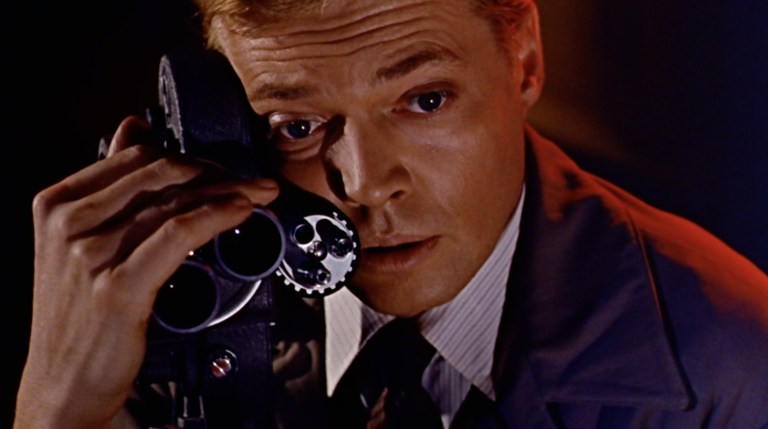
Peeping Tom (1960) is a very scary British psychological horror movie about a photographer who murders women while filming them. Some consider it the first slasher movie.
Unlike slasher movies that followed, Peeping Tom is not a murder mystery. The film is about Mark Lewis (played by Carl Boehm), who we know from the film’s first scene is the man murdering women and filming their deaths. We see him carrying out the murders as well as poring over his footage of them in his apartment.

When Mark interacts with others, he is shy and weird. Through his new friendship with a woman who lives in his building, Helen Stephens (Anna Massey), the audience understands how he came to be such a reclusive and violent adult. Mark’s father, a psychologist, performed cruel experiments on Mark throughout his young life. He also used Mark as a guinea pig, filming the entirety of his childhood hoping to learn about fear and the nervous system.
The police are puzzled by a string of murders in which each female victim died with an expression of absolute terror on her face. The audience also recalls the opening scene and how confused and then fearful victim Dora (Brenda Bruce) looked. While we know Mark killed her, there is still a bit of a twist ending that explains exactly why his victims react in such a manner (tap to reveal spoiler): Mark has fixed a mirror in front of his camera so that his victims will see their own faces contorted with fear as they die.

Here are collected trivia facts and lore about the very first slasher movie, Peeping Tom (1960):
“When Michael Powell’s Peeping Tom was originally released in England in 1960, the critics rose up like a bunch of furious Reverend Davidsons to condemn it on moral grounds. ‘It stinks,’ one critic wrote. Another said it should be flushed down the sewer, and a third dismissed it haughtily as ‘perverted nonsense.’ There is nothing angrier than a critic when he can be safely outraged.”
—Vincent Canby, The New York Times
- Peeping Tom was pulled from theaters after five days and basically ruined director Michael Powell’s career, though the film is now highly regarded and has a 96% rating on Rotten Tomatoes. While he was a respected director before its release, afterwards no one in the film industry wanted to be attached to Powell. Film critics that previously praised his work called the movie “disgusting.”
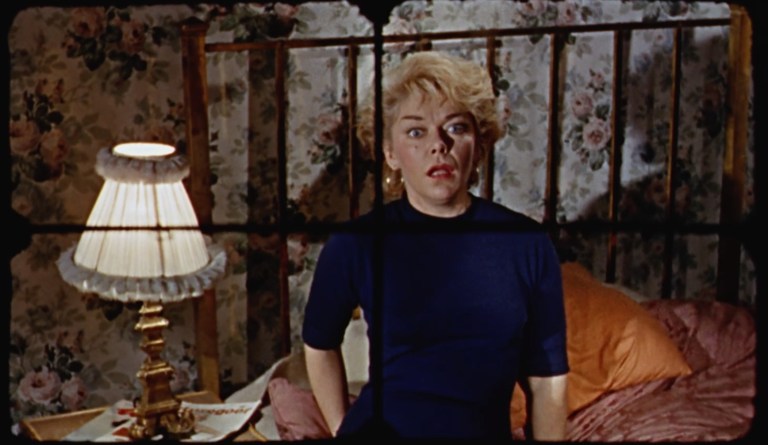
2. Just a few months later, Alfred Hitchcock’s Psycho was released. That same critic who called Peeping Tom “disgusting,” C.A. Lejeune (who even had a friendship with Hitchcock), walked out of the theater before the film was finished and quit the industry altogether. However, Psycho still managed to be a huge success, unlike Peeping Tom.
3. In the opening scene, the audience “sees” through the lens of Mark’s camera. The viewfinder is meant to remind the audience of the crosshairs on a rifle scope.
4. Roger Ebert theorized that the movie was so controversial because it called out audiences for enjoying voyeurism, the same impulse that drove Mark’s actions in the film.
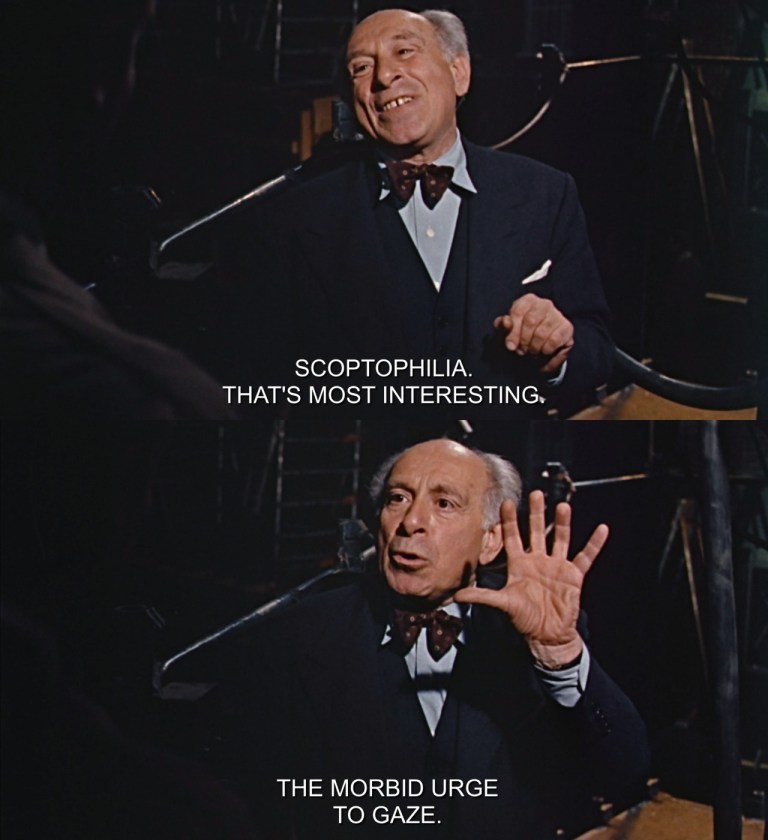
5. While ostensibly being a story about a murderous man who survived childhood abuse at the hands of his father, Peeping Tom is also a metaphor for the relationship audiences have with cinema. This is revealed in the scene where Mark talks to a visiting psychiatrist who knew his father. The psychiatrist talks about scopophilic fetishism, the pleasure we all get from being voyeurs. Not only is Mark the titular Peeping Tom because he enjoys voyeurism, we the audience are also Peeping Toms because we take pleasure in watching Peeping Tom.
“The movies make us into voyeurs. We sit in the dark, watching other people’s lives. It is the bargain the cinema strikes with us, although most films are too well-behaved to mention it.”
—Roger Ebert, review of Peeping Tom
6. Film critic Carol J. Clover argues that horror is the most self-reflective genre of film because its characters are constantly watching and referencing horror, and that relationship evolves over time. She says that in particular, Peeping Tom shows a “psychosexual theory of cinematic spectatorship.” By putting the audience in the killer’s point of view, the audience begins to identify with the killer. Peeping Tom, more than any film before it, “tells on” the audience. What we are actually doing when we watch horror movies is laid bare. This is illustrated in Mark’s monologue at the end of the film when he shows Helen his spiked camera.
“Do you know what the most frightening thing in the world is? It’s fear. So I did something very simple. Very simple. When they felt this spike touching their throats, and I knew I was going to kill them, I made them watch their own deaths. I made them see their own terror as the spike went in. And if death has a face, they saw that, too.”
Mark reveals his motive to Helen
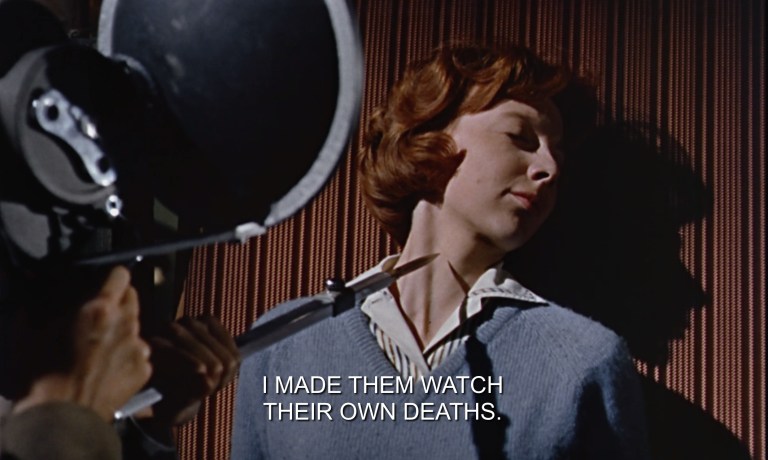
7. Michael Powell himself doesn’t even see Peeping Tom as a horror movie. He said, “It’s not a horror film…it’s a film of compassion, of observation and of memory, yes! It’s a film about the cinema from 1900 to 1960.”
8. Peeping Tom was one of the first films to put the audience in the killer’s POV, a trend that took off in the horror genre (think of the iconic tracking shots in Halloween). The actual first film to do this, however, was The Lodger (1944), directed by John Brahm. Brahm also used the device in Hangover Square (1945).
9. Writer Leo Marks based the film’s first murder (of Dora, a sex worker) on a woman he knew while working in his father’s bookstore growing up. She was also a sex worker.
10. Marks was also inspired by the Edgar Allan Poe story “The Gold-Bug,” in which a man is bitten by a gold bug and then seeks to break a code that will lead to buried treasure. This was the most well-known Poe story during his lifetime.
“I make a film that nobody wants to see and then, thirty years later, everybody has either seen it or wants to see it.”
—Michael Powell, A Life in Movies
11. Carl Boehm, the German-Austrian actor who played Mark, said he could relate to the character because his own father was a famous conductor (Karl Böhm).

12. Mark’s German accent is never explained in the film. The film is set in England and the character is supposed to have lived there his entire life.
13. Michael Powell used his real-life son and wife as actors. The three of them were all in Peeping Tom as young Mark, Mark’s father, and Mark’s mother in the home videos that adult Mark obsessively rewatched and showed Helen. He was criticized for “torturing” his son. Powell found the criticisms laughable.
14. In the novel The Silence of the Lambs by Thomas Harris, Buffalo Bill watched old home movies of his mother before killing his victims. This detail may have been inspired by Peeping Tom, but it was not shown in the film adaptation.
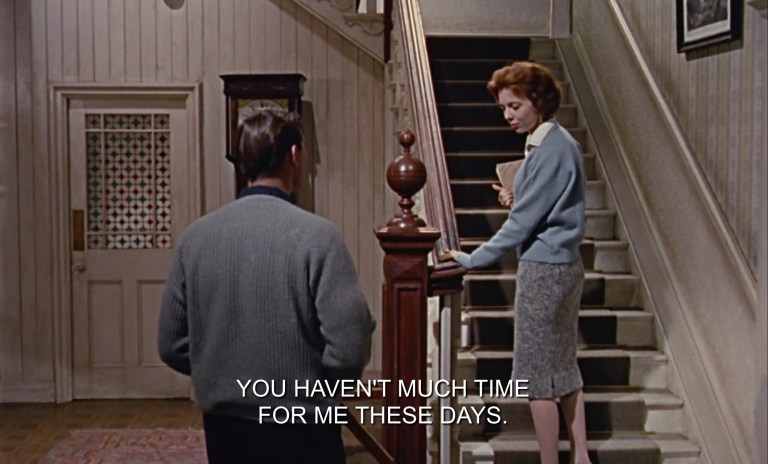
15. Director Martin Scorsese says Peeping Tom is one of his favorite movies. He was instrumental in reversing public opinion about the movie. Scorsese and Michael Powell became so close, eventually Scorsese’s longtime editor, Thelma Schoonmaker, married Powell in 1984.
“I have always felt that Peeping Tom and [Fellini’s] 8½ say everything that can be said about filmmaking, about the process of dealing with film, the objectivity and subjectivity of it and the confusion between the two. Peeping Tom shows the aggression of it, how the camera violates.”
—Martin Scorsese, Michael Powell’s ‘Peeping Tom’: the film that killed a career

16. Director Michael Powell used his first camera ever as a prop in Mark’s apartment. It was a hand-operated Eyemo camera made by Bell and Howell.
17. Pamela Green as “Milly” has the first-full frontal scene in British film history. The scene is in Mark’s final photography session before the film’s climax.
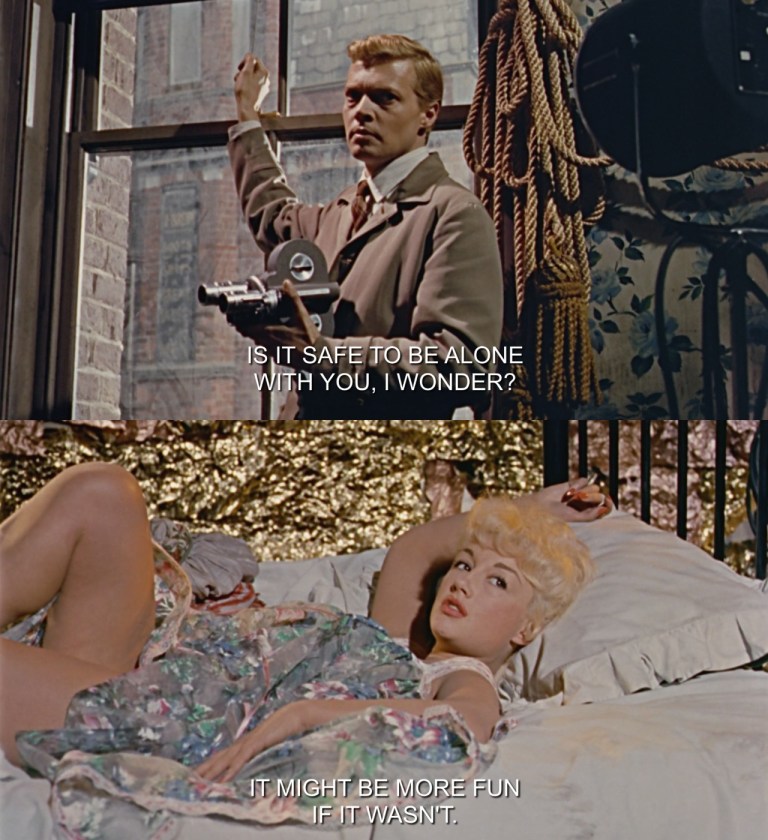
18. In real life, Pamela Green was in a relationship with a porn photographer and was a glamour model, so the role she plays isn’t far from reality.
19. Peeping Tom is about a serial murderer with daddy issues. Psycho, released the same year, is about a serial murderer with mommy issues. Together these films can be considered the mother and father (pun intended) of the slasher genre.
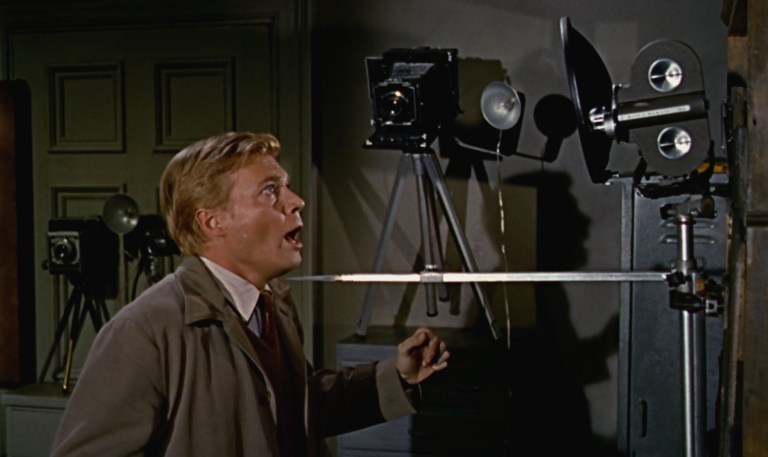
“I find I am convinced that it is a masterpiece. If in some afterlife conversation is permitted, I shall think it my duty to seek out Michael Powell and apologise.”
—Iconic film critic Dilys Powell on reversing her opinion of Peeping Tom, The Telegraph
20. British model Kate Moss starred in an ad campaign for Alexander McQueen in 2014 that reenacted Peeping Tom‘s opening scene:
21. Peeping Tom also served as inspiration for Edgar Wright in making Last Night in Soho (2021).
